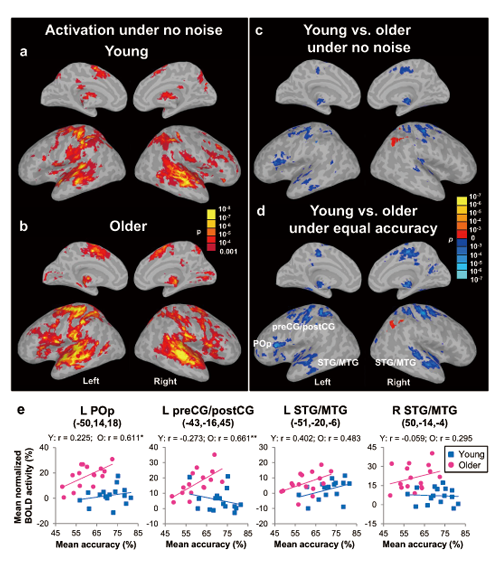Hearing loss is one of the most common chronic health conditions in older adults that affects 90 per cent of seniors who are 80 years and older. A loss of hearing greatly affects an older adult’s ability to socialize and their quality of life. Older adults even with clinically normal hearing often experience different levels of difficulties in understanding conversations in noisy environments, such as restaurants. However, how older brains process speech sounds under the challenges of impoverished hearing and declined auditory processing ability remains unclear.
As people age, their periphery and central auditory systems (areas of the brain that help to intake and interpret sounds) decline in functions and plugging into other parts of the brain is needed as a means of compensation.
A brain imaging study by Dr. DU Yi from the Institute of Psychology of Chinese Academy of Sciences and her collaborators from the Rotman Research Institute at Baycrest and University of Toronto has pinpointed speech motor areas in the frontal lobe of the brain that older adults rely on to differentiate speech sounds in background noise, which could revolutionize the treatment of hearing loss.
The study analyzed the brain activity measured with functional magnetic resonance imaging (fMRI) of 16 young and 16 older adults when they identified syllables, while the level of noise changed in the background. They found that compared to young adults, older adults had stronger activation in speech motor areas, brain regions that are important for speech articulation and production, which was associated with improved speech discrimination performance in older adults. Using a machine learning method called multivariate pattern classification, they also showed preserved specificity of speech representations in speech motor areas but not in auditory cortices in older adults’ brain. The findings suggest that to compensate for hearing loss older adults increasingly engage the speech motor areas and use the articulatory prediction information to interpret someone’s talking in a noisy room.
This finding is important because it paves the way for programs to be designed to assist seniors with hearing loss and to adapt the way hearing aids are developed. By showing there are other brain areas that affect hearing, researchers can design training programs that target these brain areas to see if we can improve their use.
The study is now published in Nature Communications .
This research was support by grants from Canadian Institutes of Health Research.
Contact:
DU Yi
Institute of Psychology, Chinese Academy of Sciences
duyi@psych.ac.cn

Figure 1. Age difference in BOLD activity. Activity elicited by syllable identification at the NoNoise condition in young (a) and older adults (b). Activity in young adults versus activity in older adults at the NoNoise condition (c) and conditions when two groups equalled in accuracy (average activity at -6 and -2 dB SNRs in young versus average activity at -2 and 8 dB SNRs in older) (d). Results are thresholded at PFWE < 0.01. (e) Correlations between the mean activity across -12 to 8 dB SNRs in four ROIs (left POp, left preCG/postCG and bilateral STG/MTG) and the mean accuracy across those SNRs in older (red circles) and young adults (blue squares). The coordinates are in Talairach space. *P < 0.05; **P < 0.01 by Pearson’s correlations. POp, pars opercularis; preCG/postCG, precentral and postcentral gyrus; STG/MTG, superior and middle temporal gyrus.
